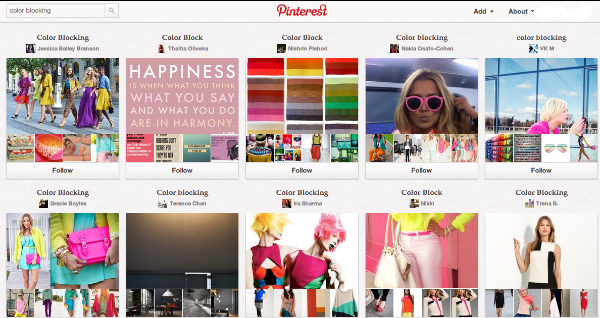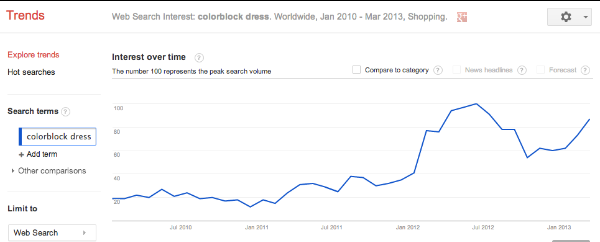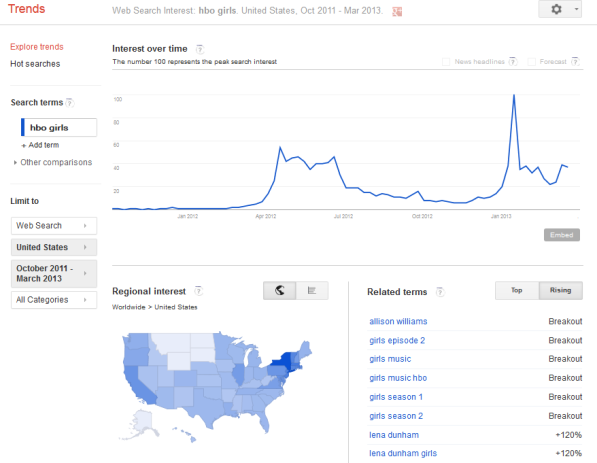In the digital age, it should come as no surprise that search trends follow the rise and fall of fashion (and cultural) trends. Or should it?
Fashionista Marie picks up her favorite magazine, covering the top 10 hot trends for spring. The editors of StyleMag have been planning features for spring since attending New York Fashion Week the previous fall. Marie scopes out a few potential dresses for her friend’s engagement party. She picks up her iPad, and types in a featured dress style, “colorblock dress.”
Rewind. Place search marketer hat on. Revisit. Everything Marie has done was entirely predictable six months ago by the close of fashion week. Google’s own search trend data substantiates this as does an audit of Pinterest results for last spring.
Forecasting (Unscientifically) Via Pinterest Trends
If 2012 is any indication, Pinterest will also start to serve as a secondary (search) forecast of which trends will sell and drive traffic. Take the “color block” trend from spring 2012. While Pinterest doesn’t provide result counts, let’s just say the scrolling of results for “color block” devotee boards and pins are endless.

Search Trend Volume Substantiated
Google’s search volumes for 2012 confirm the same popularity for “colorblock dress.” Notice the minor peak in September 2011 when the runway debuted Spring 2012 looks and then the rising interest through June 2012 as apparel lines became widely available for purchase.

Runway and Color Trends – Translated to Consumer Language
Ecommerce organizations are already on top of this – with knowledge passing sales predictions (influenced by the runway) from fashion buyers to merchant and marketing teams focused on feature and promotion planning, but SEO remains the ugly stepsister.
SEOs should follow the same process as buyers and designers. Let’s call this keyword brainstorming. Start with a list of potential product offerings to be offered on the site. For categories, ask what are the next season’s top silhouettes and product types? For products, ask what are the season’s hot colors, materials (eyelet, leather), even prints (floral, leopard)?
In addition to the runway recap, anyone supporting fashion should know the color bible that is Pantone, which produces a fashion color report for every season. Pantone provides a master list of top colors on its website for free. These tend to be the colors splashed all over runways and eventually products sold on eCommerce sites and in stores nationwide. In short, Pantone influences designer and buyer choices that make it to market.
2013’s Pantone Color of the Year is emerald green. As proof of cause and effect, Google AdWords Keyword Research Tool illustrates that monthly searches in the U.S. for “emerald dress” are currently well over 12,000.

For next fashion season, take Pantone’s listed colors and translate them into consumer friendly terms. Marigold equals yellow. Ox blood equals burgundy. Color “modifiers” matter.

These shades drive trends, search volume, conversion, and maybe even sell-through.
How to Find Current Trends
Above and beyond the runway, it’s also possible to find search trend data for a given apparel category, in a more recent time frame. Below is a snapshot of what trends were most searched in women’s apparel in the last 90 days, available for free from Google Trends. With spring on the horizon, top searches include sundresses, maxi dresses, and high waisted shorts.

The same trend investigation in the Outerwear category in the last 90 days tell us that consumers are looking for yellow raincoats as they get ready for April showers.
Cultural Trends Drive Search Volume
It isn’t just the runway that influences search trends. The First Ladies on both sides of the Atlantic have proven to set style preferences as well. Again, unsurprisingly, we see this substantiated by search volumes.
In 2011, Kate Middleton wore a navy lace dress on her trip with Prince William to Canada, which has been covered by paparazzi worldwide. Women’s interest in navy dresses has since increased gradually into 2013. Not only in terms of search volume (see below), but also in designers offering their own interpretation of the style, as evidenced by results from Google Shopping.

Ecommerce sites can capitalize on the celebrity fashion news or cultural trends the same way as editors; blogging opened doors for this opportunity years ago.

Scan a magazine rack today and you can’t miss a cover shoot of Lena Dunham, producer of the hit HBO series “Girls”. Ecommerce brand Lulus.com recent blog post featured a round up of all the Lulu’s products befitting the Girls’ characters’ styles, therein driving links to a range of products in their catalog to create SEO value. Lulus.com main demographic is also juniors, many of whom fall into the same audience as age group as the cable show.
Tying Trend Data into Your Keyword Strategy
All of these trend sources can be leveraged to develop a seasonal keyword strategy. To establish a foundation of data to work from, start with a review of:
- Editorial coverage of next season’s trends
- Trends terms in Pinterest
- Pantone’s color report
Trend data will need to be matched up with merchandising and marketing plans for the season. Key areas of focus are:
- Catalog product volume by trend
- Plans for features and categorization
- Blog and content development plans
With the right candidates in mind, trends can be translated with keyword brainstorming by product type, material, and color shade. From this master list, keyword targets should be chosen across the catalog and developed into meta data and URL recommendations.
For further trend optimization and reach, the top 10 keywords for the season should be circulated to teams in charge of social, blog, content, along with guidance around cross-linking products and categories from the blog or social properties.







Leave a Reply
You must be logged in to post a comment.